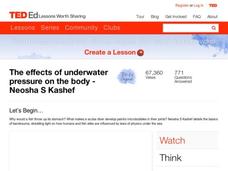Bozeman Science
Ideal Gas Law
In this video Paul Andersen explains how the pressure, volume, amount, and temperature of an ideal gas are related. Absolute zero of a gas can be determined by varying the temperature and measuring the corresponding volume of a gas...
Curated Video
Temperature: Crash Course Physics
Bridges. Bridges don't deal well with temperature changes. In order to combat this, engineers have come up with some work arounds that allow bridges to flex as they expand or contract. In this episode of Crash Course Physics, Shini talks...
Bozeman Science
Gas Pressure
In this video Paul Andersen explains how the gas pressure is the force applied over the area of the container. It is also the change in momentum as gas molecules interact with the container and is uniform throughout the sample. Several...
TED-Ed
TED-Ed: The ABC's of gas: Avogadro, Boyle, Charles - Brian Bennett
How can bottles and balloons help explain the different laws that govern gas? See how Boyle's Law, Charles' Law, and Avogadro's Law help us understand the laws that govern gas properties.
SciShow
Fun With Potatoes & Physics! A SciShow Experiment
Hank uses a favorite subject of the YouTube community - the potato gun - to teach us about the principles of pneumatics, which use the potential energy of compressed gas to do work in lots of useful machines every day.
Curated Video
Thermodynamics: Crash Course Physics
Have you ever heard of a Perpetual Motion Machine? More to the point, have you ever heard of why Perpetual Motion Machines are impossible? One of the reasons is because of the first law of thermodynamics! In this episode of Crash Course...
Bozeman Science
Second Law of Thermodynamics
In this video Paul Andersen explains how the second law of thermodynamics applies to reversible and irreversible processes. In a reversible process the net change in entropy is zero. In and irreversible process the entropy will always...
SciShow
The Physics of Roller Coasters
Roller coasters give people the opportunity to experience physics in dramatic ways. In this episode of SciShow, we break down how physics work on roller coasters to give you the ride of your life!
SciShow
The Physics of Roller Coasters
Roller coasters give people the opportunity to experience physics in dramatic ways. In this episode of SciShow, we break down how physics work on roller coasters to give you the ride of your life!
Curated Video
Pressure and Temperature of a Gas at Fixed Volume: Understanding the Relationship and Solving Calculations
This is a science lesson in which the relationship between the pressure and temperature of a gas at a fixed volume is investigated. The video uses visual aids to demonstrate how particles with kinetic energy collide with container walls...
Curated Video
The Relationship between Pressure and Volume of a Gas
This is a lecture video explaining the mathematical relationship between the pressure and volume of a gas when it is at a constant temperature and has a fixed mass. The video discusses how the pressure and volume of a gas are inversely...
Wonderscape
Science Kids: Physics of Rockets
This video is a lesson about the physics of rockets and how engineers design and build them. The teacher explains concepts such as Newton's three laws of motion, the role of forces in rocket propulsion, the importance of thrust, weight,...
Higgsino Physics
How a Drinking Bird Toy Works
This is how a dipping bird toy/ drinking bird / dunking bird works explained. Explained with animations. A drinking bird works by cooling of the head via. evaporative cooling. That will cause the liquid (dichlormethane) inside the glass...
Seeker
This 3D Quantum Gas Clock Could Redefine Time
Time may be a human construct but that hasn't stopped physicists from perfecting it. Read More: JILA’s 3-D Quantum Gas Atomic Clock Offers New Dimensions in Measurement...
Bozeman Science
Thermodynamics and P-V Diagrams
In this video Paul Andersen explains how the First Law of Thermodynamics applies to an ideal gas in a piston. A pressure-volume graph can be used to determine the type of thermodynamic process. Included is a discussion of and P-V diagram...
TED-Ed
TED-Ed: How do jetpacks work? And why don't we all have them? | Richard Browning
In 1961, Yuri Gagarin piloted a spacecraft in humanity's first manned space flight. A week later, Bell Aerosystems debuted a gas-powered rocket pack that could fly 35 meters in 13 seconds. Unfortunately, engineers knew this short flight...
Higgsino Physics
Why you can hear a train on the railway tracks from miles away
Is it possible to hear a train coming by putting an ear to the rail track? Physics of why you can detect a train in the railway tracks from miles away.Sound is actually just a pressure wave a disturbance that's kind pushing to its...
MinuteEarth
How We Learned That Water Isn't An Element
For thousands of years, water was thought to be an element. That is, until some of the greatest chemists in the world managed to crack it open.
Crash Course
Introduction to the Solar System: Crash Course Astronomy
In today's Crash Course Astronomy, Phil takes a look at the explosive history of our cosmic backyard. We explore how we went from a giant ball of gas to the system of planets and other celestial objects we have today. This episode is...
Crash Course
Temperature: Crash Course Physics #20
Temperature can be hard on outdoor structures. Learn how engineers consider thermal energy effects while constructing structures such as bridges. The video lesson also considers how heat affects gases by exploring the ideal gas laws....
TED-Ed
The Effects of Underwater Pressure on the Body
Exactly what causes the the pain you feel when diving to the deep end of a pool? Find out with this short video that explores the physical laws governing the behavior of gases and the ways they affect marine life...
Teacher's Pet
Properties of Gases
What makes gases so unique? Physical science sleuths uncover the facts about gases in a short video. The narrator compares gases to solids and liquids in terms of space between particles, compressibility, and reaction to temperature...
MinutePhysics
What is a Dimension? In 3D...and 2D...and 1D
How many dimensions are there? Latitude, longitude, and altitude are accepted dimensions, but what about time or another type of dimension? An engaging video describes how we theorize that we live in three dimensions and which laws of...
Physics Girl
How to Make a Cloud in Your Mouth
Could you make a cloud with only what you have on you right now? The video explains how to use only your mouth to create a cloud, no matter the temperature outside. It also discusses the physics principles allowing this to occur, various...









